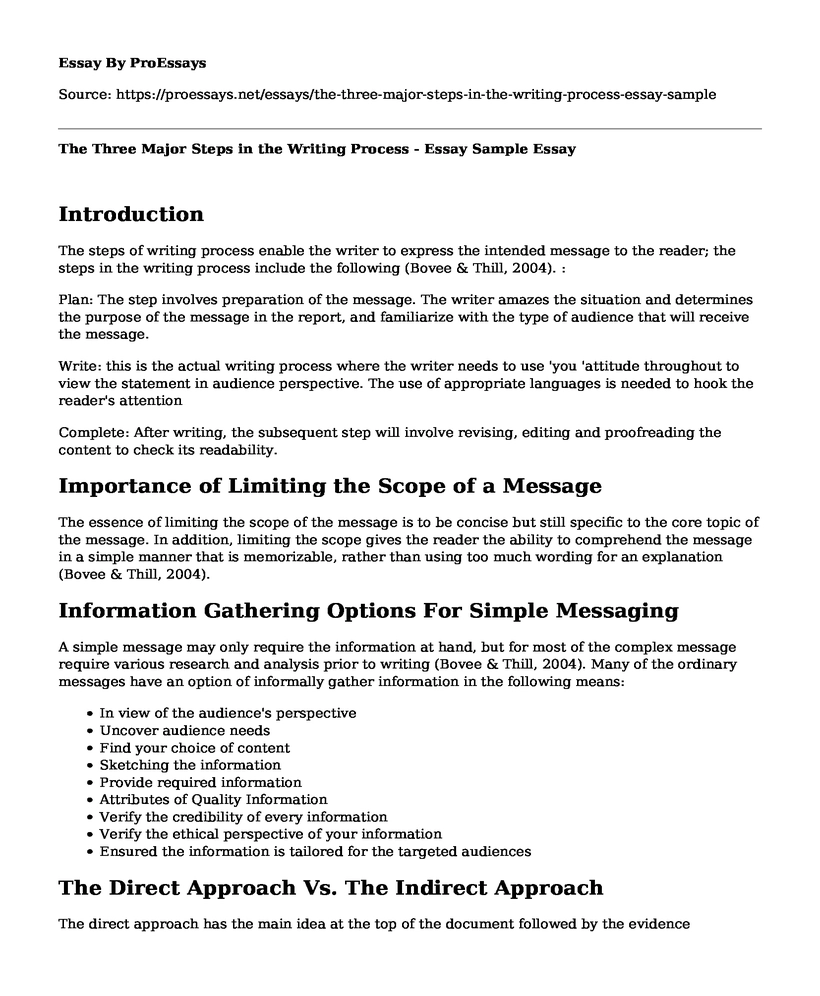Introduction
The steps of writing process enable the writer to express the intended message to the reader; the steps in the writing process include the following (Bovee & Thill, 2004). :
Plan: The step involves preparation of the message. The writer amazes the situation and determines the purpose of the message in the report, and familiarize with the type of audience that will receive the message.
Write: this is the actual writing process where the writer needs to use 'you 'attitude throughout to view the statement in audience perspective. The use of appropriate languages is needed to hook the reader's attention
Complete: After writing, the subsequent step will involve revising, editing and proofreading the content to check its readability.
Importance of Limiting the Scope of a Message
The essence of limiting the scope of the message is to be concise but still specific to the core topic of the message. In addition, limiting the scope gives the reader the ability to comprehend the message in a simple manner that is memorizable, rather than using too much wording for an explanation (Bovee & Thill, 2004).
Information Gathering Options For Simple Messaging
A simple message may only require the information at hand, but for most of the complex message require various research and analysis prior to writing (Bovee & Thill, 2004). Many of the ordinary messages have an option of informally gather information in the following means:
- In view of the audience's perspective
- Uncover audience needs
- Find your choice of content
- Sketching the information
- Provide required information
- Attributes of Quality Information
- Verify the credibility of every information
- Verify the ethical perspective of your information
- Ensured the information is tailored for the targeted audiences
The Direct Approach Vs. The Indirect Approach
The direct approach has the main idea at the top of the document followed by the evidence (deductive argument). The indirect approach presents evidence at the top then followed by the main ideas (an inductive argument) (Bovee & Thill, 2004).
Essay with Key Terms from Chapter
Mobile technology promotes social and professional experiences. Mobile technology has revolutionized how people access the internet. Nearly 80% of internet users use mobile phone technology, and many advantages are identified with technology. Many of the business in the contemporary world are dependent on mobile technology as it boosts productivity among the employees and brings the customers and business partner closer in communication wise. The mobile communication tools have eased the way business operates and how people get in touch with one another. For example, note-taking apps such as Note Taker HD offer a flexible and unobstructed means to take notes. Also, wearable technology such as smart watches offers fascinating possibilities for business communication. For example, Uno Noteband incorporates Spritz speed-reading that ease the speed of reading message content. Mobile apps are essential in executing business tasks from research to the presentation and promote the collaboration among the employees. Also, the operates serves as sensory and cognitive extensions
Both social media and mobile communication are changing the nature of communication. The major challenge in mobile technology is its compatibility with the websites. Mobile phones have become a personal device more compared to the PC; therefore, the users expect the websites to be compatible with mobile phone technology, particularly smartphones. The website should not only incline on the conventional PC screen but also instead design for the optimum viewing on the tablets and smartphones since the device size matters. The small mobile displays are cumbersome in developing and consuming content, either by typing an email or watching a video. Also, message texting brings a challenge in the readability of the content in terms of the grammar and punctuation
Reference
Bovee, C. L., & Thill, J. V. (2004). Business communication today. Prentice Hall.
Cite this page
The Three Major Steps in the Writing Process - Essay Sample. (2022, Nov 08). Retrieved from https://proessays.net/essays/the-three-major-steps-in-the-writing-process-essay-sample
If you are the original author of this essay and no longer wish to have it published on the ProEssays website, please click below to request its removal:
- Creative Writing Stories on Personal Experience
- Creating Awareness About Immunizations Paper Example
- Essay Sample on Surrealist Film: Rejecting Theatrical Psychology & Challenging Art
- Essay Example on Pitch Quality: Finding the Right Pitch for Your Audience
- Tracing the Evolution of Art: A Study of Five Art History Movements
- Essay on Body Safety Education: Essential for Schools to Protect Children from Sexual Abuse
- Research Paper: The Role Culture Plays in Misunderstandings of Nonverbal Communication in the Classroom







